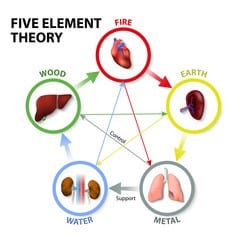Chinese Medicine is deeply rooted in Daoist philosophy, with the five elements serving as a foundation for understanding how the world was created. Ancient philosophers sought to understand the meaning and purpose of life, tracing all existence to the five elements: wood, fire, earth, water, and metal. This principle applies on both a macrocosmic and microcosmic scale, influencing everything from the smallest atom to the largest organism and the entire universe.
The Role of the Five Elements in Chinese Medicine
In Traditional Chinese Medicine (TCM), the five elements play a vital role in balancing the body’s energies, particularly the energetic flow of each organ and its associated channel. This balance impacts not only physical health but also mental and emotional well-being, guiding personality traits and supporting overall health.
Historical Background of Five Element Theory
The five-element theory, also known as the five phases or “Wu Xing,” has been central to Chinese medicine for thousands of years. The five elements are prominently mentioned in one of the earliest texts, Huang Di Neijing (dating back to 300 B.C.). Today, this theory remains essential to the practice of Traditional Chinese Medicine, guiding practitioners in diagnosis and treatment differentiation.
Overview of the Five Elements and Their Associations
Each of the five elements in Chinese medicine is linked to specific natural aspects, including seasons, organs, sensory organs, and emotions. Below is a summary:
| Element | Season | Yin organ | Yang organ | Sense organ | Fluid Taste Emotion |
| wood | spring | liver | gallbladder | eyes | tears sour anger |
| fire | summer | heart | small intestine | tongue | sweat bitter joy/laughter |
| earth | none | pancreas | stomach | mouth | saliva sweet worry/over thinking |
| metal | fall | Lung | large intestine | nose | mucus pungent grief/sadness |
| water | winter | Kidney | urinary bladder | ears | urine salty fear |
Applying the Five Elements in Acupuncture Treatment
In acupuncture, practitioners often select points on meridians (channels) based on the five-element theory. Here’s how it may look in practice:
Example 1 – Treating Digestive Disorders with the Wood Element
A patient presents with digestive issues such as bloating, pain, gas, and acid reflux. After a thorough examination, including tongue and pulse diagnosis and a detailed history, the acupuncturist may diagnose that the wood element (liver) is “overacting” on the stomach. Since the liver governs emotional flow, an imbalance might manifest as anger or frustration. The treatment will focus on rebalancing wood’s influence over the digestive system.
Example 2 – Addressing Respiratory Issues with the Metal Element
Another patient has a cough-producing mucus but without cold symptoms (sneezing, sore throat). After a comprehensive intake and pulse/tongue assessment, the acupuncturist might determine that the metal element (lungs) is in excess, impacting the earth (stomach). Using the five-element theory, the practitioner would select acupuncture points and possibly recommend an herbal remedy.
Conclusion
This introductory look at the five elements of Chinese Medicine shows how TCM incorporates them for holistic diagnosis and treatment. Future posts will explore each aspect in more depth, detailing their unique characteristics and impact on health.




